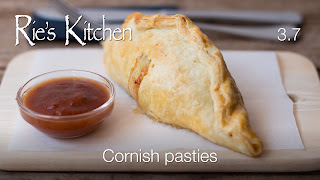Cornish Pasties, Gluten Free, episode 3.7
There is a lot of tradition surrounding pasties. My mum's family, the Allen's were Cornish miners who emigrated to Australia during the gold rush of the 1850's. They eventually settled in Bendigo, and their mining skills were put to good use. They brought with them, many family recipes, and the recipe I am sharing with you today is one of them. I have heard many family debates over whether peas should be included in the recipe. In my household this was a distinct "no!" but a number of my cousins would vehemently disagree. The choice is yours.
Cornish Pasties have received PGI (Protected Geographical Indication). A PGI is created to protect regional foods that have a specific quality, reputation or other characteristic attributable to that area. It acts like a trade mark, and stops manufacturers from outside the region copying a regional product. This doesn't stop us making them at home.
Cornish pasties have a distinct look - they have the pastry folded at the top, creating a handle. These calorie filled parcels were taken down into the mines for the miners meals. Some historians state that the handle could then be thrown away, not contaminating the food with their dirty hands. This is due to the use of arsenic in the tin mines. This does seem wasteful, in a time when food was expensive and nothing was wasted.
Making pasties in my house was always an all-in-affair. Dad was in charge of rolling out the puff pastry; Mum minced the vegetables and then put the filling onto the circles of pastry; my brother brushed the edges with milk; and I folded them together and pricked the sides once they went on the tray. Then we all waited together for them to come out of the oven, golden brown and tasting amazing!
I am privileged to be the custodian of the cast iron mincer. It has an amazing story that I have shared in my cookbook "Origins".
Below is our family recipe. You can also see the tricks in making pasties from my Youtube video below
Recipe
Cornish Pasties have received PGI (Protected Geographical Indication). A PGI is created to protect regional foods that have a specific quality, reputation or other characteristic attributable to that area. It acts like a trade mark, and stops manufacturers from outside the region copying a regional product. This doesn't stop us making them at home.
Cornish pasties have a distinct look - they have the pastry folded at the top, creating a handle. These calorie filled parcels were taken down into the mines for the miners meals. Some historians state that the handle could then be thrown away, not contaminating the food with their dirty hands. This is due to the use of arsenic in the tin mines. This does seem wasteful, in a time when food was expensive and nothing was wasted.
Making pasties in my house was always an all-in-affair. Dad was in charge of rolling out the puff pastry; Mum minced the vegetables and then put the filling onto the circles of pastry; my brother brushed the edges with milk; and I folded them together and pricked the sides once they went on the tray. Then we all waited together for them to come out of the oven, golden brown and tasting amazing!
I am privileged to be the custodian of the cast iron mincer. It has an amazing story that I have shared in my cookbook "Origins".
Below is our family recipe. You can also see the tricks in making pasties from my Youtube video below
Recipe
Makes 10-12
• 2 packets of puff pastry sheets (gf)
• 750 g minced meat
• 1 swede (neep)
• 2 potatoes
• 5 carrots
• 1 tbl salt
• Milk
• 1 egg, beaten
Preheat oven to 190°C fan/210°C.
Mince together all the vegetables using a food processor. Mix with the minced meat and salt.
Stand the bowl at an angle to allow some of the liquid to drain away, whilst you prepare the pastry. If the filling is too moist, the pasties will leak juices and soften the pastry whilst waiting to go into the oven.
Roll out the puff pasty sheets till approximately 3 mm thick. Using a bread and butter plate as your template, cut a circle of pastry. Spoon a large spoonful of mixture on to the middle of the circle.
Using a pastry brush, paint the edges of the circle with milk.
Fold together the two halves of the pastry over the filling, gently pressing the edges together. Roll the join to get a good seal, thus making the 'handle' of the pastie and gently twist the ends together.
Continue with remaining pastry until all ingredients are used. It is ok to reroll the scraps of pastry from each sheet.
Place on a lined baking tray.
Using a fork, prick both sides of the pasty to allow air to escape. Brush the pasties with the beaten egg.
Place in oven for 25 minutes until golden brown.
Serve with homemade tomato sauce.
Updated April 2023





Comments